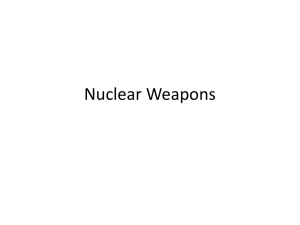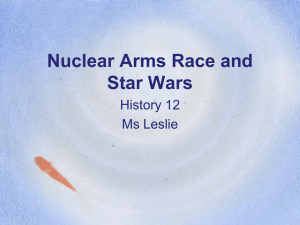Future Nuclear Weapons Policies
advertisement
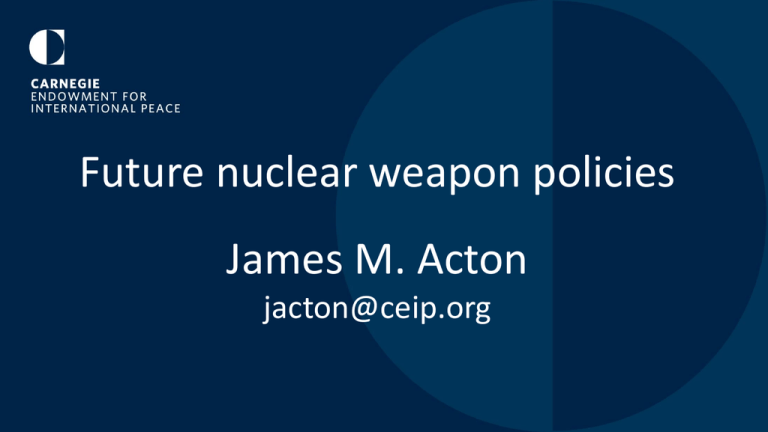
Future nuclear weapon policies James M. Acton jacton@ceip.org (Some) elements of nuclear posture • Force size and structure • • Military Organization • • Warhead production/maintenance facilities; industrial base; test facilities Declaratory policy • • • Command and control; early warning; ISR; targeting Infrastructure • • Troops; training; procedures; operations Enabling systems • • Deployed and reserve systems; readiness status Statements; training and exercises; domestic discourse War plans Treaty obligations Questions raised by reductions • Can U.S. fulfill “deterrence” requirements? • Will weapons reach target? • • Will weapons destroy target? • • • • • Reliability; pre- and post-launch survivability Yield, accuracy and target location error Can requirements be revised? How will allies/adversaries view U.S. resolve and capability? What will the effects on “strategic stability” be? … Current U.S. force structure Platform Missile Warhead ICBM (Silo based) Minuteman III W78; W87 SLBM Ohio-class SSBN Trident-D5 W76-0/1; W88 Heavy Bombers B-2 (Gravity bombs) B61-7/11; B83-1 B-52H ALCM W80-1 (+ gravity bombs) F-15E; F-16C/D (Gravity bombs) B61-3/4/10 “Tactical” fighters Future of the triad • Political context crucial; in practice force structure will be determined by politics of the moment as much as nuclear strategy • • • ICBM replacement will probably be delayed further (beyond 2020); early abandonment very unlikely (jobs!) Very strong support for SLBMs Multiple decision points related to heavy bombers and tactical fighters coming up • Air leg most vulnerable Arguments for heavy bombers and tactical fighters • Unique ability to hold buried targets at risk • But, how much do these targets really matter? • Stealth as alternative to speed for defense penetration • But, how likely is effective BMD? • Recallable • But, how many war plan options include only aircraft? • Forward deployment as tool for assurance • But, are there alternatives? • Signaling as tool for crisis management A growing role for conventional weapons in strategic war plans? DoD is directed to conduct deliberate planning for non-nuclear strike options to assess what objectives and effects could be achieved through integrated non-nuclear strike options, and to propose possible means to make these objectives and effects achievable. Although they are not a substitute for nuclear weapons, planning for non-nuclear strike options is a central part of reducing the role of nuclear weapons. Report on Nuclear Employment Strategy of the United States (2013) • Probably not about large-scale replacement. Types of target in a “counterforce” attack against North Korea • Fixed, soft targets • ICBM sitting on a launch pad • Fixed, buried targets • • Warhead storage facilities; leadership; command and control Probably tens, potentially hundreds of metres deep • Mobile, soft targets • Road-mobile missiles Massive ordnance penetrator • Total mass: 13,600 kg • HE mass: 2,400 kg • Can reportedly penetrate to 20 m in reinforced concrete (much less than nuclear weapons) Physics of conventional penetrators Young Penetration Equation (SI Units) 𝑚 𝐷 = 0.000018 𝑆 𝑁 𝐴 0.7 𝑉 − 30.5 D: Depth S: Penetrability of target N: Nose performance coefficient m: Mass A: Cross sectional area V: Speed • From Nelson (2002) CPGS technological approaches Comparison of penetrator effectiveness 𝑚 𝐷 = 0.000018 𝑆 𝑁 𝐴 0.7 𝑉 − 30.5 MOP CPGS V (m/s) 500 [?] 1,000-1,200 m/A (kg/m) 27,000 14,000-21,000 • Ratio of penetration depths: 1.3-2.1 • CPGS penetrator would only contain about 10% of the HE that MOP does. Mobile missile hunting • • • Need to locate and track missiles If using standoff weapons need to provide inflight target updates (or risk waiting until they’re stationary) North Korea has hundreds of mobile ballistic missiles • • • Only a small fraction might contain a nuclear warhead, but very hard to tell which is which 1991 Gulf War: 1,460 sorties; 0 confirmed kills 2006 Israel-Hizbollah war: 80-90% of Hizbollah’s medium- and longrange rocket launchers destroyed. But, took time and relied on attacking launchers after missiles has fired. Nuclear v. conventional options • Lethal radius from flechette weapon: <100 m, possibly much less (my calculation) • TEL can traverse this distance in 10 s • Lethal radius from 100 kT nuclear weapon: 2,900 m (McKinzie et al. 2001) • TEL can traverse this distance in 260 s • Hunting mobile missiles with conventional weapons much harder than nuclear weapons


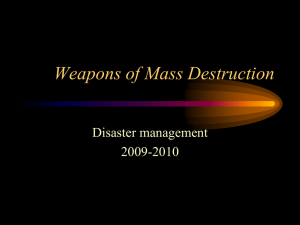
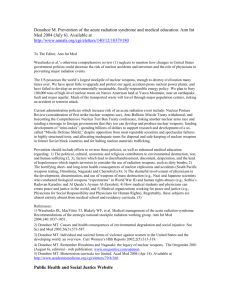

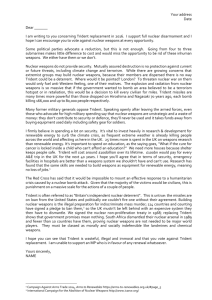

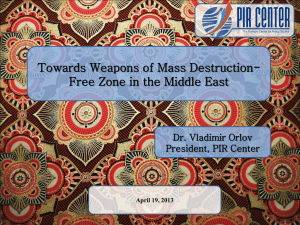
![The Politics of Protest [week 3]](http://s2.studylib.net/store/data/005229111_1-9491ac8e8d24cc184a2c9020ba192c97-300x300.png)
